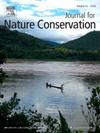南非夸祖鲁-纳塔尔省东北部受保护地区(Hluhluwe-iMfolozi公园、iSimangaliso湿地公园)和未受保护地区(Giba农村社区)铺砌道路上爬行动物的统计数据
IF 2.5
3区 环境科学与生态学
Q2 BIODIVERSITY CONSERVATION
引用次数: 0
摘要
人为变化是爬行动物面临的全球性威胁,爬行动物面临着栖息地改变、剥削和迫害等多种威胁。许多人为的变化依赖于道路网络,爬行动物特别容易受到与道路对周围栖息地的直接和间接影响有关的死亡率的影响。本研究旨在确定南非夸祖鲁-纳塔尔省Hluhluwe-iMfolozi公园、iSimangaliso湿地公园和邻近的吉巴农村社区受保护和未受保护地区铺砌道路上爬行动物的人口统计学和死亡率。我们通过观察活的和死的个体来确定爬行动物的物种多样性和丰度,绘制占用热点分布,并确定一系列生态因素对观察到的爬行动物存在的影响。我们的研究包括沿着Hluhluwe-iMfolozi公园的R618和R22的铺砌道路部分,R22穿过iSimangaliso湿地公园和Giba农村社区。在2021年3月至2023年3月的日出和日落驱动调查期间收集存在数据。保护区与非保护区爬行动物总数差异不显著。然而,大多数死亡(78.3%)是道路死亡,在受保护地区和未受保护地区观察到的活的和死的个体数量之间存在显著差异。在观察到的个体中,蛇占大多数(70.3%)。爬行动物观察频率随生境退化和缺水而降低,随车辆密度的增加而增加。我们的研究强调了受保护和未受保护地区的道路对爬行动物物种的影响,并且为了更有效地保护,必须减少道路的影响。本文章由计算机程序翻译,如有差异,请以英文原文为准。
Reptile demographics on paved roads in protected (Hluhluwe-iMfolozi Park, iSimangaliso Wetland Park) and unprotected areas (Giba Rural Community) in northeastern KwaZulu-Natal, South Africa
Anthropogenic change is a global threat to reptiles, and species face numerous threats, including habitat change, exploitation, and persecution. Much anthropogenic change is dependent on road networks, and reptiles are particularly susceptible to mortality related to the direct and indirect effects of roads on surrounding habitats. Our study aimed to determine the demographics and mortalities of reptiles on paved roads in protected and unprotected areas in Hluhluwe-iMfolozi Park, iSimangaliso Wetland Park and the adjacent rural community of Giba in KwaZulu-Natal Province, South Africa. We achieved this by observing live and dead individuals to determine reptilian species diversity, and abundance, mapping occupancy hotspot distributions and determining the effect of a suite of ecological factors on observed reptile presence. Our study included sections of paved roads along the R618 in Hluhluwe-iMfolozi Park and the R22, which passes through iSimangaliso Wetland Park and the rural community of Giba. Presence data were collected during driven surveys at sunrise and sunset from March 2021 to March 2023. Total reptile numbers were not significantly different between protected and unprotected areas. However, the majority (78.3%) were found as road mortalities, with a significant difference between the number of live and dead individuals observed between protected and unprotected areas. Snakes comprised the majority (70.3%) of observed individuals. Reptile observation frequencies decreased with habitat degradation and the absence of water, while they increased with increases in vehicle density. Our study highlights the impact of roads in protected and unprotected areas on reptile species, and that mitigation is necessary for more effective conservation.
求助全文
通过发布文献求助,成功后即可免费获取论文全文。
去求助
来源期刊

Journal for Nature Conservation
环境科学-生态学
CiteScore
3.70
自引率
5.00%
发文量
151
审稿时长
7.9 weeks
期刊介绍:
The Journal for Nature Conservation addresses concepts, methods and techniques for nature conservation. This international and interdisciplinary journal encourages collaboration between scientists and practitioners, including the integration of biodiversity issues with social and economic concepts. Therefore, conceptual, technical and methodological papers, as well as reviews, research papers, and short communications are welcomed from a wide range of disciplines, including theoretical ecology, landscape ecology, restoration ecology, ecological modelling, and others, provided that there is a clear connection and immediate relevance to nature conservation.
Manuscripts without any immediate conservation context, such as inventories, distribution modelling, genetic studies, animal behaviour, plant physiology, will not be considered for this journal; though such data may be useful for conservationists and managers in the future, this is outside of the current scope of the journal.
 求助内容:
求助内容: 应助结果提醒方式:
应助结果提醒方式:


